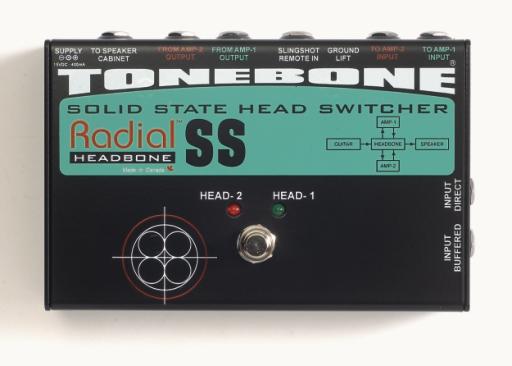MusicRadar Verdict
If your perfect rig includes more diverse amps than a back-street pawn shop, here's a cool way to hook them together and get some great sounds.
Pros
- +
It switches without any noise and the changeover is seamless with no difference to your tone.
Cons
- -
Nothing: the Head-bone does exactly what it says on the tin.
MusicRadar's got your back
In the never-ending search for great tone, many guitarists have discovered the trick of using two or more different amp/speaker combinations and effects chains with dissimilar voicings to create wider and more varied sounds.
Listen carefully to recordings by ZZ Top, Led Zeppelin, Aerosmith, the Stones and many others, and you'll often hear at least two amps on guitar parts, adding all kinds of unique textures that just can't be achieved from one source.
It's one thing to experiment with an assortment of amps, effects and speakers in a studio environment, but quite another to transfer it to a live stage.
All of a sudden, the attendant problems of impedance and level matching, ground loops and portability cause far more hassle.
Of course, if you happen to play in a multi-platinum band the solution is simple: pay someone to sort it out.
Today, most modern pro guitar rigs use MIDI to activate relays, routing signals through different amps and loops, or changing settings on suitably-equipped amps like Mesa's new Stiletto head, often with custom intermediate level-matching preamps and impedance-matching isolation transformers to keep everything clean.
Serious systems like this are too expensive for most mortals. However, you can go a long way down the multiple amp/loop road using analogue switching, and three new products from Radial Engineering - the Head-bone, Loop-bone and Cab-bone - greatly expand your options.
All three switchers are housed in heavy steel boxes with clearly legible graphics to explain their functions. And to underline their pro standard they all come with a decent external power supply delivering a beefy 15 volts DC.
Overview
The Head-bone is a neat solution to one problem that frequently crops up. How can you switch a guitar signal between two amp heads while using one cabinet?
One problem here is leaving the amp disconnected from its loudspeaker for any length of time.
In a valve amp, a no-load situation means that output transformers and valves will overheat and may short-circuit, while in solid-state amps the output devices are also at risk from back EMF (reverse current from moving loudspeakers acting as generators), so there are actually three Head-bones: one for valve, one for solid state and one to handle both types, to specifically address these dangers.
Inside the box, ultra-fast relays, photocells and load resistors are controlled by microchips that precisely time the opening and closing sequences, so that when you step on the switch several things happen all at once.
Firstly, the guitar's output signal is muted and then the output of the amp that was in service is diverted to a substantial built-in dummy load inside the Head-bone's chassis, before the second amp (which was connected to the dummy load) is connected to the loudspeaker output.
Finally, the guitar is routed from one amp's input jack to the other and then switched on again.
All of this happens in a tiny fraction of a second; to all intents and purposes, the changeover is virtually seamless and instantaneous.
In the event of a power supply failure, the Head-bone goes into failsafe mode, connecting head 1 to the loudspeaker cabinet by default.
In use
The unit behaved perfectly with no hum, no clicks and no pops, despite a pretty extreme test.
Designed and built to Radial's usual uncompromisingly high standards, this clever device brings pro-standard switching capability within reach of the dedicated weekend warrior for the first time.
It isn't cheap, but compared to off-the-peg alternatives from the likes of Skrydstrup, or a custom-made MIDI-powered rig from Pete Cornish or Bob Bradshaw, it is excellent value for money with few readily available competitors.

“We were able to fire up a bass sound that was indistinguishable from the flavour of New Order’s Blue Monday in seconds”: EastWest Sounds Iconic review

“How long did it take me to get over it? Oh, quite a while”: Brian May on the “supreme injustice” of Roger Taylor’s Queen B-side "making as much money as Bohemian Rhapsody"

“Clem was not just a drummer; he was the heartbeat of Blondie. He was a source of inspiration both on and off the stage”: Clem Burke, drummer for Blondie, dead at 70









